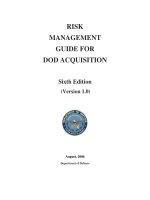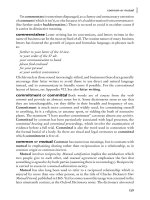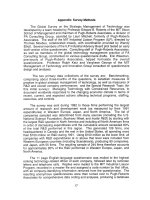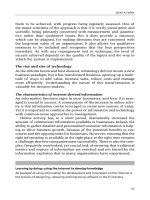Risk Management Guide for Information Technology Systems phần 3 docx
Bạn đang xem bản rút gọn của tài liệu. Xem và tải ngay bản đầy đủ của tài liệu tại đây (236.95 KB, 10 trang )
SP 800-30
Page 16
Vulnerability Threat-Source Threat Action
Data center uses water sprinklers
to suppress fire; tarpaulins to
protect hardware and equipment
from water damage are not in
place
Fire, negligent persons Water sprinklers being
turned on in the data center
Recommended methods for identifying system vulnerabilities are the use of vulnerability
sources, the performance of system security testing, and the development of a security
requirements checklist.
It should be noted that the types of vulnerabilities that will exist, and the methodology needed to
determine whether the vulnerabilities are present, will usually vary depending on the nature of
the IT system and the phase it is in, in the SDLC:
• If the IT system has not yet been designed, the search for vulnerabilities should focus
on the organization’s security policies, planned security procedures, and system
requirement definitions, and the vendors’ or developers’ security product analyses
(e.g., white papers).
• If the IT system is being implemented, the identification of vulnerabilities should be
expanded to include more specific information, such as the planned security features
described in the security design documentation and the results of system certification
test and evaluation.
• If the IT system is operational, the process of identifying vulnerabilities should
include an analysis of the IT system security features and the security controls,
technical and procedural, used to protect the system.
3.3.1 Vulnerability Sources
The technical and nontechnical vulnerabilities associated with an IT system’s processing
environment can be identified via the information-gathering techniques described in Section
3.1.2. A review of other industry sources (e.g., vendor Web pages that identify system bugs and
flaws) will be useful in preparing for the interviews and in developing effective questionnaires to
identify vulnerabilities that may be applicable to specific IT systems (e.g., a specific version of a
specific operating system). The Internet is another source of information on known system
vulnerabilities posted by vendors, along with hot fixes, service packs, patches, and other
remedial measures that may be applied to eliminate or mitigate vulnerabilities. Documented
vulnerability sources that should be considered in a thorough vulnerability analysis include, but
are not limited to, the following:
• Previous risk assessment documentation of the IT system assessed
• The IT system’s audit reports, system anomaly reports, security review reports, and
system test and evaluation reports
• Vulnerability lists, such as the NIST I-CAT vulnerability database
()
SP 800-30
Page 17
• Security advisories, such as FedCIRC and the Department of Energy’s Computer
Incident Advisory Capability bulletins
• Vendor advisories
• Commercial computer incident/emergency response teams and post lists (e.g.,
SecurityFocus.com forum mailings)
• Information Assurance Vulnerability Alerts and bulletins for military systems
• System software security analyses.
3.3.2 System Security Testing
Proactive methods, employing system testing, can be used to identify system vulnerabilities
efficiently, depending on the criticality of the IT system and available resources (e.g., allocated
funds, available technology, persons with the expertise to conduct the test). Test methods
include
• Automated vulnerability scanning tool
• Security test and evaluation (ST&E)
• Penetration testing.
6
The automated vulnerability scanning tool is used to scan a group of hosts or a network for
known vulnerable services (e.g., system allows anonymous File Transfer Protocol [FTP],
sendmail relaying). However, it should be noted that some of the potential vulnerabilities
identified by the automated scanning tool may not represent real vulnerabilities in the context of
the system environment. For example, some of these scanning tools rate potential vulnerabilities
without considering the site’s environment and requirements. Some of the “vulnerabilities”
flagged by the automated scanning software may actually not be vulnerable for a particular site
but may be configured that way because their environment requires it. Thus, this test method
may produce false positives.
ST&E is another technique that can be used in identifying IT system vulnerabilities during the
risk assessment process. It includes the development and execution of a test plan (e.g., test
script, test procedures, and expected test results). The purpose of system security testing is to
test the effectiveness of the security controls of an IT system as they have been applied in an
operational environment. The objective is to ensure that the applied controls meet the approved
security specification for the software and hardware and implement the organization’s security
policy or meet industry standards.
Penetration testing can be used to complement the review of security controls and ensure that
different facets of the IT system are secured. Penetration testing, when employed in the risk
assessment process, can be used to assess an IT system’s ability to withstand intentional attempts
to circumvent system security. Its objective is to test the IT system from the viewpoint of a
threat-source and to identify potential failures in the IT system protection schemes.
6
The NIST SP draft 800-42, Network Security Testing Overview, describes the methodology for network system
testing and the use of automated tools.
SP 800-30
Page 18
The results of these types of optional security testing will help identify a system’s vulnerabilities.
3.3.3 Development of Security Requirements Checklist
During this step, the risk assessment personnel determine whether the security requirements
stipulated for the IT system and collected during system characterization are being met by
existing or planned security controls. Typically, the system security requirements can be
presented in table form, with each requirement accompanied by an explanation of how the
system’s design or implementation does or does not satisfy that security control requirement.
A security requirements checklist contains the basic security standards that can be used to
systematically evaluate and identify the vulnerabilities of the assets (personnel, hardware,
software, information), nonautomated procedures, processes, and information transfers
associated with a given IT system in the following security areas:
• Management
• Operational
• Technical.
Table 3-3 lists security criteria suggested for use in identifying an IT system’s vulnerabilities in
each security area.
Table 3-3. Security Criteria
Security Area Security Criteria
Management Security
• Assignment of responsibilities
• Continuity of support
• Incident response capability
• Periodic review of security controls
• Personnel clearance and background investigations
• Risk assessment
• Security and technical training
• Separation of duties
• System authorization and reauthorization
• System or application security plan
Operational Security
• Control of air-borne contaminants (smoke, dust, chemicals)
• Controls to ensure the quality of the electrical power supply
• Data media access and disposal
• External data distribution and labeling
• Facility protection (e.g., computer room, data center, office)
• Humidity control
• Temperature control
• Workstations, laptops, and stand-alone personal computers
SP 800-30
Page 19
Security Area Security Criteria
Technical Security
• Communications (e.g., dial-in, system interconnection, routers)
• Cryptography
• Discretionary access control
• Identification and authentication
• Intrusion detection
• Object reuse
• System audit
The outcome of this process is the security requirements checklist. Sources that can be used in
compiling such a checklist include, but are not limited to, the following government regulatory
and security directives and sources applicable to the IT system processing environment:
• CSA of 1987
• Federal Information Processing Standards Publications
• OMB November 2000 Circular A-130
• Privacy Act of 1974
• System security plan of the IT system assessed
• The organization’s security policies, guidelines, and standards
• Industry practices.
The NIST SP 800-26, Security Self-Assessment Guide for Information Technology Systems,
provides an extensive questionnaire containing specific control objectives against which a
system or group of interconnected systems can be tested and measured. The control objectives
are abstracted directly from long-standing requirements found in statute, policy, and guidance on
security and privacy.
The results of the checklist (or questionnaire) can be used as input for an evaluation of
compliance and noncompliance. This process identifies system, process, and procedural
weaknesses that represent potential vulnerabilities.
Output from Step 3
A list of the system vulnerabilities (observations)
7
that could be exercised
by the potential threat-sources
3.4 STEP 4: CONTROL ANALYSIS
The goal of this step is to analyze the controls that have been implemented, or are planned for
implementation, by the organization to minimize or eliminate the likelihood (or probability) of a
threat’s exercising a system vulnerability.
7
Because the risk assessment report is not an audit report, some sites may prefer to address the identified
vulnerabilities as observations instead of findings in the risk assessment report.
SP 800-30
Page 20
To derive an overall likelihood rating that indicates the probability that a potential vulnerability
may be exercised within the construct of the associated threat environment (Step 5 below), the
implementation of current or planned controls must be considered. For example, a vulnerability
(e.g., system or procedural weakness) is not likely to be exercised or the likelihood is low if there
is a low level of threat-source interest or capability or if there are effective security controls that
can eliminate, or reduce the magnitude of, harm.
Sections 3.4.1 through 3.4.3, respectively, discuss control methods, control categories, and the
control analysis technique.
3.4.1 Control Methods
Security controls encompass the use of technical and nontechnical methods. Technical controls
are safeguards that are incorporated into computer hardware, software, or firmware (e.g., access
control mechanisms, identification and authentication mechanisms, encryption methods,
intrusion detection software). Nontechnical controls are management and operational controls,
such as security policies; operational procedures; and personnel, physical, and environmental
security.
3.4.2 Control Categories
The control categories for both technical and nontechnical control methods can be further
classified as either preventive or detective. These two subcategories are explained as follows:
• Preventive controls inhibit attempts to violate security policy and include such
controls as access control enforcement, encryption, and authentication.
• Detective controls warn of violations or attempted violations of security policy and
include such controls as audit trails, intrusion detection methods, and checksums.
Section 4.4 further explains these controls from the implementation standpoint. The
implementation of such controls during the risk mitigation process is the direct result of the
identification of deficiencies in current or planned controls during the risk assessment process
(e.g., controls are not in place or controls are not properly implemented).
3.4.3 Control Analysis Technique
As discussed in Section 3.3.3, development of a security requirements checklist or use of an
available checklist will be helpful in analyzing controls in an efficient and systematic manner.
The security requirements checklist can be used to validate security noncompliance as well as
compliance. Therefore, it is essential to update such checklists to reflect changes in an
organization’s control environment (e.g., changes in security policies, methods, and
requirements) to ensure the checklist’s validity.
Output from Step 4
List of current or planned controls used for the IT system to mitigate the
likelihood of a vulnerability’s being exercised and reduce the impact of such an adverse event
SP 800-30
Page 21
3.5 STEP 5: LIKELIHOOD DETERMINATION
To derive an overall likelihood rating that indicates the probability that a potential vulnerability
may be exercised within the construct of the associated threat environment, the following
governing factors must be considered:
• Threat-source motivation and capability
• Nature of the vulnerability
• Existence and effectiveness of current controls.
The likelihood that a potential vulnerability could be exercised by a given threat-source can be
described as high, medium, or low. Table 3-4 below describes these three likelihood levels.
Table 3-4. Likelihood Definitions
Likelihood Level Likelihood Definition
High The threat-source is highly motivated and sufficiently capable, and controls to
prevent the vulnerability from being exercised are ineffective.
Medium The threat-source is motivated and capable, but controls are in place that may
impede successful exercise of the vulnerability.
Low The threat-source lacks motivation or capability, or controls are in place to
prevent, or at least significantly impede, the vulnerability from being exercised.
Output from Step 5
Likelihood rating (High, Medium, Low)
3.6 STEP 6: IMPACT ANALYSIS
The next major step in measuring level of risk is to determine the adverse impact resulting from
a successful threat exercise of a vulnerability. Before beginning the impact analysis, it is
necessary to obtain the following necessary information as discussed in Section 3.1.1:
• System mission (e.g., the processes performed by the IT system)
• System and data criticality (e.g., the system’s value or importance to an organization)
• System and data sensitivity.
This information can be obtained from existing organizational documentation, such as the
mission impact analysis report or asset criticality assessment report. A mission impact analysis
(also known as business impact analysis [BIA] for some organizations) prioritizes the impact
levels associated with the compromise of an organization’s information assets based on a
qualitative or quantitative assessment of the sensitivity and criticality of those assets. An asset
criticality assessment identifies and prioritizes the sensitive and critical organization information
assets (e.g., hardware, software, systems, services, and related technology assets) that support the
organization’s critical missions.
SP 800-30
Page 22
If this documentation does not exist or such assessments for the organization’s IT assets have not
been performed, the system and data sensitivity can be determined based on the level of
protection required to maintain the system and data’s availability, integrity, and confidentiality.
Regardless of the method used to determine how sensitive an IT system and its data are, the
system and information owners are the ones responsible for determining the impact level for
their own system and information. Consequently, in analyzing impact, the appropriate approach
is to interview the system and information owner(s).
Therefore, the adverse impact of a security event can be described in terms of loss or degradation
of any, or a combination of any, of the following three security goals: integrity, availability, and
confidentiality. The following list provides a brief description of each security goal and the
consequence (or impact) of its not being met:
• Loss of Integrity. System and data integrity refers to the requirement that
information be protected from improper modification. Integrity is lost if unauthorized
changes are made to the data or IT system by either intentional or accidental acts. If
the loss of system or data integrity is not corrected, continued use of the contaminated
system or corrupted data could result in inaccuracy, fraud, or erroneous decisions.
Also, violation of integrity may be the first step in a successful attack against system
availability or confidentiality. For all these reasons, loss of integrity reduces the
assurance of an IT system.
• Loss of Availability. If a mission-critical IT system is unavailable to its end users,
the organization’s mission may be affected. Loss of system functionality and
operational effectiveness, for example, may result in loss of productive time, thus
impeding the end users’ performance of their functions in supporting the
organization’s mission.
• Loss of Confidentiality. System and data confidentiality refers to the protection of
information from unauthorized disclosure. The impact of unauthorized disclosure of
confidential information can range from the jeopardizing of national security to the
disclosure of Privacy Act data. Unauthorized, unanticipated, or unintentional
disclosure could result in loss of public confidence, embarrassment, or legal action
against the organization.
Some tangible impacts can be measured quantitatively in lost revenue, the cost of repairing the
system, or the level of effort required to correct problems caused by a successful threat action.
Other impacts (e.g., loss of public confidence, loss of credibility, damage to an organization’s
interest) cannot be measured in specific units but can be qualified or described in terms of high,
medium, and low impacts. Because of the generic nature of this discussion, this guide designates
and describes only the qualitative categories—high, medium, and low impact (see Table 3.5).
SP 800-30
Page 23
Table 3-5. Magnitude of Impact Definitions
Magnitude of
Impact
Impact Definition
High
Exercise of the vulnerability (1) may result in the highly costly loss of
major tangible assets or resources; (2) may significantly violate, harm, or
impede an organization’s mission, reputation, or interest; or (3) may result
in human death or serious injury.
Medium
Exercise of the vulnerability (1) may result in the costly loss of tangible
assets or resources; (2) may violate, harm, or impede an organization’s
mission, reputation, or interest; or (3) may result in human injury.
Low
Exercise of the vulnerability (1) may result in the loss of some tangible
assets or resources or (2) may noticeably affect an organization’s
mission, reputation, or interest.
Quantitative versus Qualitative Assessment
In conducting the impact analysis, consideration should be given to the advantages and
disadvantages of quantitative versus qualitative assessments. The main advantage of the
qualitative impact analysis is that it prioritizes the risks and identifies areas for immediate
improvement in addressing the vulnerabilities. The disadvantage of the qualitative analysis is
that it does not provide specific quantifiable measurements of the magnitude of the impacts,
therefore making a cost-benefit analysis of any recommended controls difficult.
The major advantage of a quantitative impact analysis is that it provides a measurement of the
impacts’ magnitude, which can be used in the cost-benefit analysis of recommended controls.
The disadvantage is that, depending on the numerical ranges used to express the measurement,
the meaning of the quantitative impact analysis may be unclear, requiring the result to be
interpreted in a qualitative manner. Additional factors often must be considered to determine the
magnitude of impact. These may include, but are not limited to—
• An estimation of the frequency of the threat-source’s exercise of the vulnerability
over a specified time period (e.g., 1 year)
• An approximate cost for each occurrence of the threat-source’s exercise of the
vulnerability
• A weighted factor based on a subjective analysis of the relative impact of a specific
threat’s exercising a specific vulnerability.
Output from Step 6
Magnitude of impact (High, Medium, or Low)
SP 800-30
Page 24
3.7 STEP 7: RISK DETERMINATION
The purpose of this step is to assess the level of risk to the IT system. The determination of risk
for a particular threat/vulnerability pair can be expressed as a function of
• The likelihood of a given threat-source’s attempting to exercise a given vulnerability
• The magnitude of the impact should a threat-source successfully exercise the
vulnerability
• The adequacy of planned or existing security controls for reducing or eliminating
risk.
To measure risk, a risk scale and a risk-level matrix must be developed. Section 3.7.1 presents a
standard risk-level matrix; Section 3.7.2 describes the resulting risk levels.
3.7.1 Risk-Level Matrix
The final determination of mission risk is derived by multiplying the ratings assigned for threat
likelihood (e.g., probability) and threat impact. Table 3.6 below shows how the overall risk
ratings might be determined based on inputs from the threat likelihood and threat impact
categories. The matrix below is a 3 x 3 matrix of threat likelihood (High, Medium, and Low)
and threat impact (High, Medium, and Low). Depending on the site’s requirements and the
granularity of risk assessment desired, some sites may use a 4 x 4 or a 5 x 5 matrix. The latter
can include a Very Low /Very High threat likelihood and a Very Low/Very High threat impact to
generate a Very Low/Very High risk level. A “Very High” risk level may require possible
system shutdown or stopping of all IT system integration and testing efforts.
The sample matrix in Table 3-6 shows how the overall risk levels of High, Medium, and Low are
derived. The determination of these risk levels or ratings may be subjective. The rationale for
this justification can be explained in terms of the probability assigned for each threat likelihood
level and a value assigned for each impact level. For example,
• The probability assigned for each threat likelihood level is 1.0 for High, 0.5 for
Medium, 0.1 for Low
• The value assigned for each impact level is 100 for High, 50 for Medium, and 10 for
Low.
SP 800-30
Page 25
Table 3-6. Risk-Level Matrix
Impact
Threat
Likelihood
Low
(10)
Medium
(50)
High
(100)
High (1.0)
Low
10 X 1.0 = 10
Medium
50 X 1.0 = 50
High
100 X 1.0 = 100
Medium (0.5)
Low
10 X 0.5 = 5
Medium
50 X 0.5 = 25
Medium
100 X 0.5 = 50
Low (0.1)
Low
10 X 0.1 = 1
Low
50 X 0.1 = 5
Low
100 X 0.1 = 10
Risk Scale: High ( >50 to 100); Medium ( >10 to 50); Low (1 to 10)
8
3.7.2 Description of Risk Level
Table 3-7 describes the risk levels shown in the above matrix. This risk scale, with its ratings of
High, Medium, and Low, represents the degree or level of risk to which an IT system, facility, or
procedure might be exposed if a given vulnerability were exercised. The risk scale also presents
actions that senior management, the mission owners, must take for each risk level.
Table 3-7. Risk Scale and Necessary Actions
Risk Level
Risk Description and Necessary Actions
High
If an observation or finding is evaluated as a high risk, there is a
strong need for corrective measures. An existing system may
continue to operate, but a corrective action plan must be put in place
as soon as possible.
Medium
If an observation is rated as medium risk, corrective actions are
needed and a plan must be developed to incorporate these actions
within a reasonable period of time.
Low
If an observation is described as low risk, the system’s DAA must
determine whether corrective actions are still required or decide to
accept the risk.
Output from Step 7
Risk level (High, Medium, Low)
8
If the level indicated on certain items is so low as to be deemed to be "negligible" or non significant (value is <1
on risk scale of 1 to 100), one may wish to hold these aside in a separate bucket in lieu of forwarding for
management action. This will make sure that they are not overlooked when conducting the next periodic risk
assessment. It also establishes a complete record of all risks identified in the analysis. These risks may move to a
new risk level on a reassessment due to a change in threat likelihood and/or impact and that is why it is critical
that their identification not be lost in the exercise.









